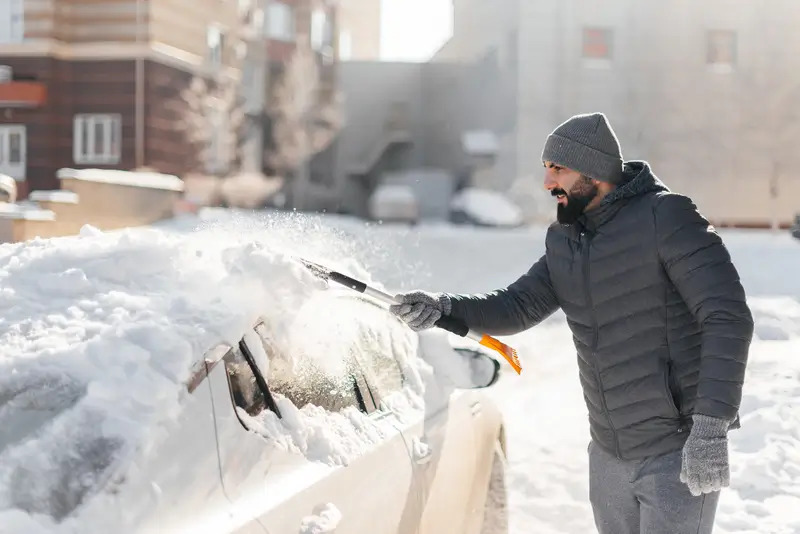
Virginia has very snowy winters every year. While snow can be a beautiful and calming sight, it can also be deadly. Driving during and after a snowfall is sometimes inevitable. But proper care is imperative to keep you and others safe on the roads.
While Virginia law does not require it, cleaning snow off your car is essential. When a driver fails to do so, it could significantly impair their ability to see clearly and drive safely. If you get into a crash caused by someone else’s negligence, contact the legal team at River Run Law. We can help you get compensated for losses.
But let’s help ensure that you don’t cause such a crash by looking at how important it is to get that snow and ice off your car before heading out.
Why Is Snow and Ice on My Vehicle Dangerous?
Having snow and ice on your vehicle can be very dangerous for you, your passengers, and everyone near you on the road. If you are not in the habit of cleaning snow off your car before driving, serious issues may arise.
Visibility Issues
As we all know, if you leave your vehicle outside when it’s snowing, your windows will get covered in snow, impairing your visibility. If you only clear the snow off your windows, you can still have trouble. For instance, if you stop abruptly or drive fast the snow on top of the roof can fall onto your front or back windshield, impairing your visibility.
This can cause devastating accidents such as hitting another car, a cyclist, or a pedestrian. There’s also the risk that the sudden lack of visibility can result in you veering off the road and hitting a tree, object, person, or building.
Flying Projectiles
Snow and ice might also fly off your vehicle in a compact chunk. This flying debris can cause serious injuries to pedestrians and bicyclists or hit another car, causing an accident. If the projectiles consist of ice, then they are hard and may have the ability to crack another car’s windshield.
Do Any Laws Require Me to Remove Snow and Ice from My Vehicle?
No, not presently. A bill was presented to the Virginia legislature in January 2022 regarding snow and ice removal. The proposed law would make it a traffic infraction to drive with snow and ice on your vehicle’s surface, which could interfere with another vehicle or cause harm to a person or property.
Violation of the law would be punishable by a fine of $100. However, this law appears to have died in committee and has yet to be passed by the legislature.
Although there is no law requiring you to remove snow and ice from your vehicle, you could be held financially responsible if your failure to do so causes an accident. It’s important to be proactive so you can do your part to keep the roads safe.
What Are the Consequences If I Drive with Snow and Ice on My Car?
Driving with snow and ice on your vehicle can have serious consequences.
Suffer Serious Injuries
If snow and ice interfere with your ability to drive your car, you may be injured in an accident. These injuries can range from minor to life-threatening injuries such as:
- Broken bones,
- Laceration,
- Burns,
- Traumatic brain injury,
- Spinal cord injuries,
- Paralysis,
- Amputation, and
- Coma.
Some of these injuries can cause permanent problems and can drastically affect your life.
Liable for Negligence
Failing to take proper safety precautions—regardless of whether they are codified into law or not—can result in liability for a crash.
For example, suppose you failed to remove snow from your car and that snow blew off your car and onto the front windshield of the car next to you. The snow blocked the other driver’s view of the road and they crashed into a tree.
That injured driver can file a negligence claim against you. They can argue you had a duty to drive safely and you failed to do so when you left the snow on your car. That failure was the cause of the snow blocking their view of the road and led to the crash.
Increased Insurance Cost
If you are injured in an accident caused by the snow on your car, your insurance rates will go up. This means more money out of your pocket.
Similarly, if a negligence claim is successful against you, you will owe the injured party damages. This most likely will be paid by your insurance company.
However, if the costs to the victim are higher than your insurance coverage—you might be personally liable for the difference. Such a claim can also cause your insurance rates to increase.
How to Remove Snow from Your Car
Protecting your car from snow and ice during the snowy season helps keep you and other drivers safe. The best option is to keep your car in your garage or a parking garage. But sometimes this is not feasible and your car is exposed to the snow.
Removing snow and ice from your vehicle is actually not difficult. Follow these steps:
- Use a snow brush. Use a snowbrush to remove the softer, fluffy snow that falls on your car. A combination of a snowbrush and an ice scraper can be used to remove harder snow and ice.
- Turn on your vehicle. You’ve probably turned on your vehicle only to run back into the house and wait for the car to warm up in the morning before work. The heat from a car can also help to melt the ice and snow on the car.
- Defrost your windows. Turn on your defrosters. They can help to clear the fog that settles on your windows and also can assist in melting the ice and snow.
- Check your windshield wipers. Make sure you clear any snow from the windshield wipers.
Once you learn these strategies, it’ll be easy to remember for next time. Be sure to give yourself time to remove the snow and ice from your car. The length of time you should allocate depends on the severity of the snowfall and freezing temperatures. Generally, be prepared for an extra 20 minutes.
Contact River Run Law
If you or a loved one were injured in an accident as a driver, cyclist, or pedestrian, contact the experienced personal injury attorneys at River Run Law. Speak to a seasoned attorney about your situation in a free case evaluation.
Where You Can Find Our Richmond Office Location

